What is Amethyst?
Amethyst is a member of the Quartz group of crystals. It is found in shades of purple ranging from pale lilac to a deep, rich purple color that seems to flash with red and blue when turned to the light. Amethyst is a relatively hard crystal, measuring 7 on the Mohs scale.
It is often found in clusters and geodes and is a popular stone for jewelry and ornaments.
Amethyst has a vitreous luster and its crystalline structure is hexagonal (trigonal).
It is sometimes heat-treated to change its color, either to improve the depth of purple or to produce Citrine, which is yellow, although this is not common.
The Origin: Where Is Amethyst Found?
Amethyst occurs wherever you would find Quartz, particularly in igneous rocks, metamorphosed rocks, alpine-type fissures, hydrothermal veins, and rocks deposited by hot springs.
The best quality Amethyst is Siberian, as this was the site where the richest purple colored Amethyst was first mined.
However, the term “Siberian” is now used to denote stones of the highest quality, whether mined in Siberia or elsewhere.
Amethyst is found in abundance in Sri Lanka, Brazil, Uruguay, and the Far East.
All that is needed for the more common Clear Quartz to transform into Amethyst is a dose of natural radiation.
The History & Lore of Amethyst
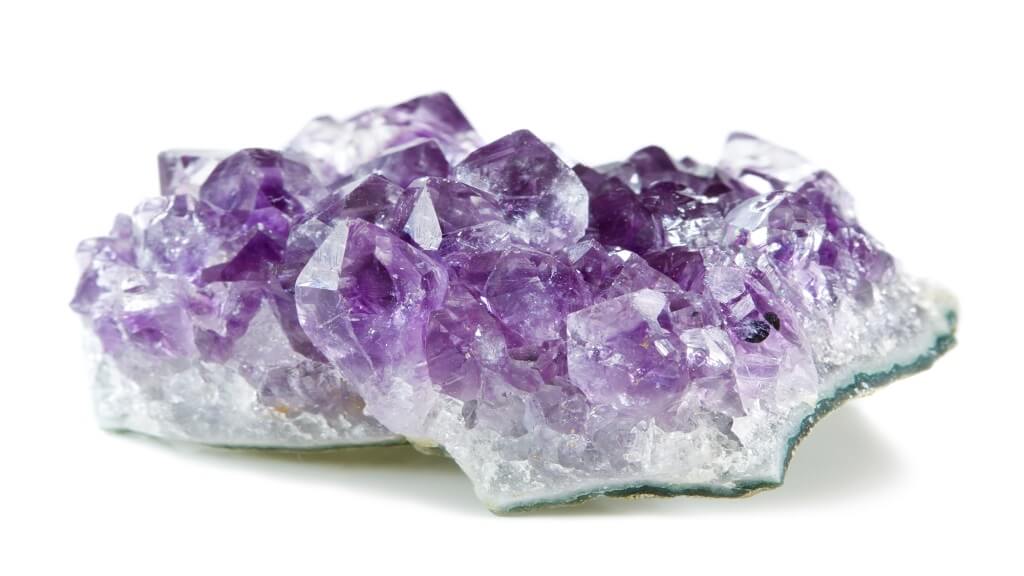
Amethyst, along with many other gemstones, minerals, rocks, and crystals, has a fascinating history.
We humans, have ever been captivated by shiny things, and, over thousands of years, our preoccupation with these natural treasures has led to various qualities being attributed to the crystals we have become fond of.
The name Amethyst comes from the ancient Greek word amethystos, which simply means “not drunk” and this quality, of promoting sobriety, has been acknowledged by other cultures over time.
It was believed that drinking from amethyst encrusted goblets, or holding a piece of the stone in the mouth while drinking wine, would prevent the user from becoming intoxicated.
In Greek mythology, Amethyst was a rock crystal dyed purple by the tears of Dionysus, the god of revelry and excess.
The Roman version
The Roman version of the myth says that the god Bacchus, god of wine, grapes, and intoxication, became enamored of Amethyst, a chaste maiden who rejected his overtures and pursued her relentlessly.
Amethyst prayed to the gods for help in remaining chaste and was rewarded by Diana, the goddess of chastity (and hunting).
Diana turned Amethyst into a white stone in order to preserve her chastity.
Bacchus was so humbled by this sacrifice that he poured wine over the stone as an offering, dyeing it purple.
The alleged quality of conferring sobriety, and seriousness of mind also seems to have cropped up in other cultures over the centuries.
Ancient Britons prized Amethyst as an aid to wisdom and courage, qualities much to be desired in leaders and warriors.
Ancient Egyptians
The Egyptians used Amethyst as the representative of the zodiac sign of the goat, goats being the enemies of vineyards.
Other benefits attributed to the stone include protection from psychic attack, stimulation of psychic powers such as clairvoyance, and the ability to connect physical, mental, emotional, and spiritual bodies so that the whole is balanced and integrated for optimum well-being.
Throughout history we find only good qualities being attributed to Amethyst.
Amethyst was thought to help business people in the making of shrewd decisions, protect warriors when going into battle, ward off evil and the forces of darkness, and promote in the bearer a calm, judicious frame of mind.
Religion and Rulers
Amethyst also has religious connotations, possibly due to the fact that purple dye was at one time the most expensive and only used for vestments of the highest nobility and priesthood.
The Royal Purple of the raiment worn by the highest clerics in Christianity, for example, reflects the value placed on the color, and, by association, on the stone itself.
During the Middle Ages, Amethyst came to symbolize piety and celibacy and was used to adorn religious symbols and the highest ranking clerics in the form of medallions, rings, and amulets.
Amethyst was also believed to stand for humility and modesty and, during the Renaissance was especially prized by Monarchs who wanted to show that they exhibited these qualities despite the privileged positions they held in the social order.
It was on the twelve stones that adorned the breastplate of the high priest Aaron, and later represented the tribe of Dan, one of the twelve tribes of Israel.
Mystical and Metaphysical History
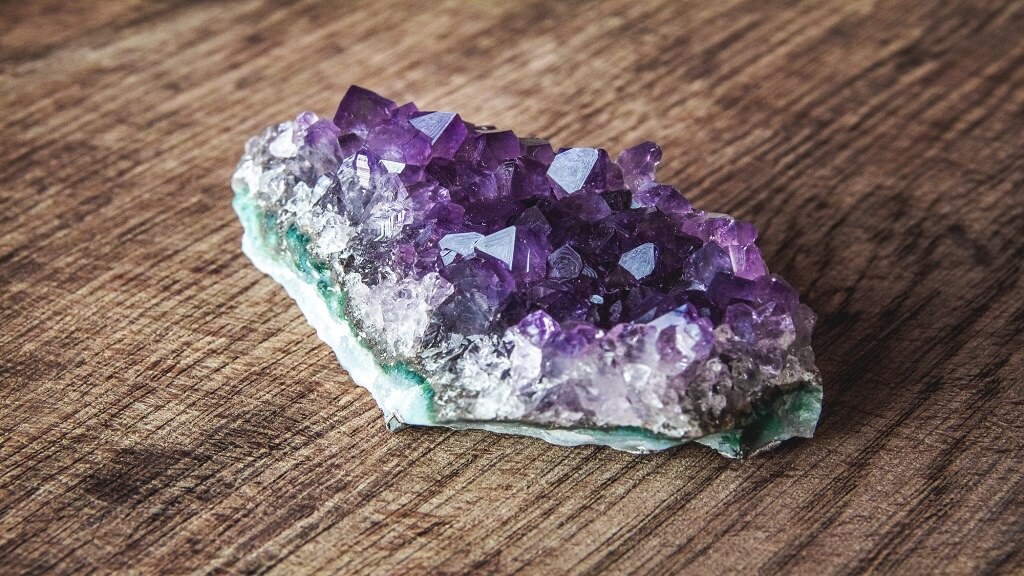
In the Chinese tradition of Feng Shui, Amethyst is used in the wealth corner to encourage the advent of abundance in material possessions and finance.
In Yogic and Ayurvedic philosophies, especially regarding the chakras and the transmission of Life Force Energy through the meridians of the body.
Amethyst is most strongly associated with the Third Eye or Brow chakra.
This chakra is the seat of prophecy, clarity of vision, and connection to the Divine wisdom that provides insight and wisdom.
Amethyst is said to be one of the most spiritual stones and is often used in meditation to facilitate connection with Higher powers and the angelic realms.
Amethyst “scrying stones” were very popular with mediums and spiritualists in Victorian England.
Contrary to popular belief, the “crystal ball” which formed a fortune teller’s stock-in-trade was very rarely crystal clear.
Cheaper, sham versions of the fortune teller’s equipment included glass spheres more for the aesthetic appeal of a “clear vision” and because they were cheaper than spheres made from crystal.
Amethyst and Clear Quartz scrying stones were actually of far more use to the practitioner or seer because the flaws and inclusions that make the stones opaque afforded a much better focus.
By concentrating on the intricate patterns appearing in the crystal, the seer could achieve a state of meditative trance, during which they accessed the knowledge, messages, symbols, and other signs they needed in order to ply their trade.
Description of Amethyst
Amethyst is a form of Quartz and is relatively common, being found in many sites throughout the world. It gets its purple coloring from inclusions of other minerals, mainly manganese and iron.
It can take the form of small chippings or enormous clusters and geodes. It comes in a variety of colors, from the palest lilac to deep, rich purples.
It is a popular crystal for use in jewelry and ornaments or statues.
Like Clear Quartz it is believed to possess a wide range of attributes and benefits, including its ability to absorb negative or harmful substances from the atmosphere and environment.
How to Identify Amethyst
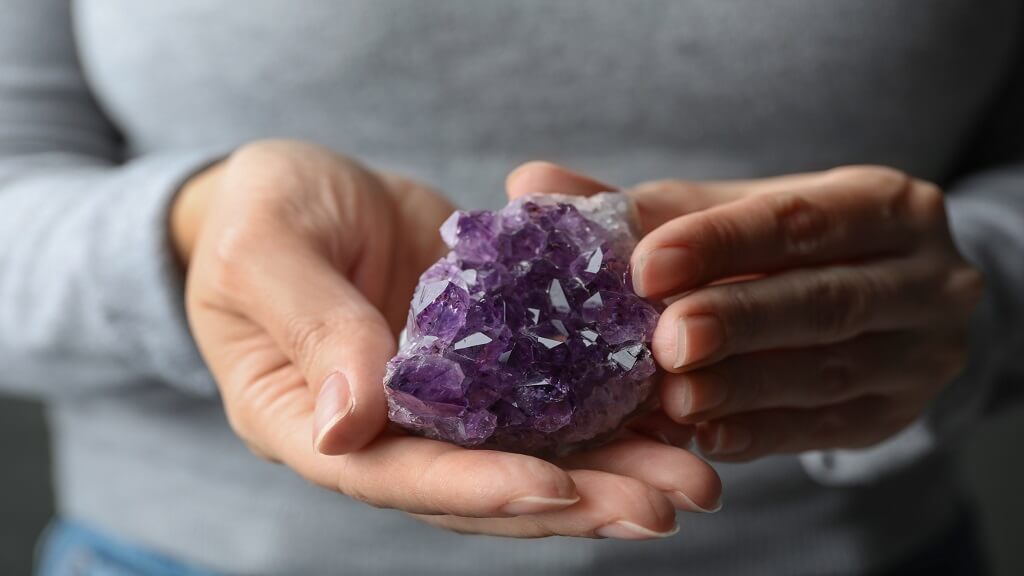
Temperature
As Amethyst is a popular choice in jewelry making and tumble stones, it should come as no surprise to find that there are some Amethyst fakes around.
There are several things you can do to tell whether the Amethyst you are buying is real or not.
The easiest one is to simply hold the stone in your hand for a minute or so.
True Amethyst is able to hold quite a low temperature even when exposed to direct sunlight.
If the stone you are holding picks up your body heat after a minute or so you are probably looking at a fake.
Hardness
Amethyst registers 7 on the Mohs scale of hardness, meaning that it should be able to scratch anything below that on the scale.
For example, an ordinary nail measures 2 on the scale, and a good quality kitchen knife measures 6.5.
Amethyst should be able to scratch both of these items, and indeed any mineral that comes below 7 on the scale.
Visual Test
If the Amethyst you are looking at seems to have no imperfections it is probably not genuine.
Natural rocks and minerals have a variety of flaws, including tiny fissures, specks of other minerals, and changes in color zones.
Quartz Structure
Some gems show the effects of bubbling within their structure. Amethyst does not have this type of structure.
As a member of the Quartz group, it should exhibit thread-like lines within the crystal.
Types of Amethyst
Amethyst can combine naturally with other minerals during its formation to produce slightly different varieties.
It can also be heat treated to change its color from purple to yellow, forming Ametrine.
Types of naturally occurring Amethyst include the following:
Brandburg Amethyst
This attractive variety is found only in Namibia, Africa, and is a combination of Clear Quartz, Smoky Quartz, and Amethyst.
It is said to be of an especially high vibration and has some remarkable formations visible within its depths, from phantoms to anhydrous.
Its metaphysical qualities include potent healing and protection frequencies.
Chevron Amethyst
This form displays V-shaped chevrons of deep purple and white Quartz in layers that seem to bleed into each other.
It is said to be one of the finest Third-Eye stones, stimulating vision within oneself as well as within the energies of the cosmos.
Prasiolite
Prasiolite is sometimes, incorrectly, referred to as “Green Amethyst and is in fact a yellow to a yellow-green variety of quartz that is cut into faceted stones for use in jewelry.
It is produced artificially by human hands in three different ways.
Amethyst is either heat-treated in a laboratory oven to about 500 degrees Celsius, or it is irradiated, producing a paler shade of green that is quite unstable.
Prasiolite can occur naturally where Amethyst is heated for a second time by volcanic or other heat sources.
Amethyst Birthstone Meaning & History
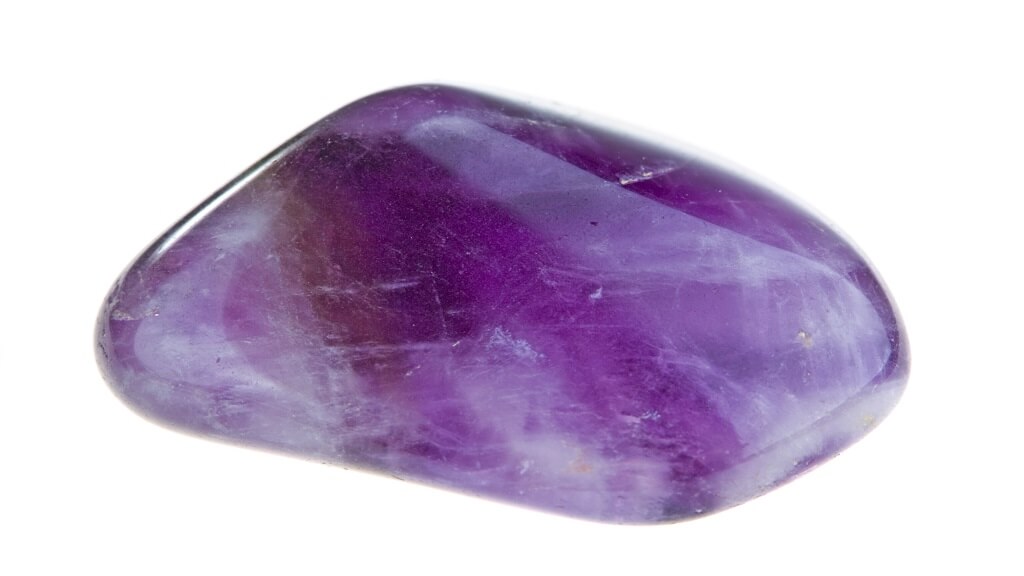
Amethyst is the official birthstone for the month of February.
Because of its durability, it makes the perfect stone for use in a variety of jewelry items and is therefore easy to gift to anyone whose birthday falls in the second month of the year.
Birthstones are said to reflect some of the qualities of the signs of the zodiac that fall within the month of February.
Aquarius and Pisces both fall into this category.
If you are an Aquarius you will know that your sign is in fact an air sign, not water as the name may indicate.
Aquarians are often intellectual deep thinkers, with a strong sense of fairness and horror of injustice.
They tend to spend a lot of time in introspective thought and many are empaths who want to make the world a better place.
Amethyst is an ideal stone for them as it is aligned with the Third Eye chakra, giving access to inner wisdom and the ability to plan for the future, and the Crown, which is the seat of the intellect and logical thinking.
Pisces people are often creative and imaginative, with a tendency towards day dreaming.
They are emotionally sensitive and thrive in situations in which they feel both useful and valued.
The healing qualities of Amethyst that most benefit a Pisces are its ability to protect the wearer from negative emotional or psychic vibes from others, and its quality of enhancing psychic gifts in order to expand spirituality.
How to Clean and Care for Amethyst
Caring for your Amethyst is fairly simple, owing to the fact that it is a robust and durable stone, not easily scratched or damaged.
If you have Amethyst jewelry you can clean it with a soft brush and mild soap before rinsing thoroughly and drying either in the air or with a soft cloth.
Amethyst crystals do not need to be “charged” as most other stones do, meaning that they will continue to hold their metaphysical qualities and vibration without the need for spiritual cleansing.
An Amethyst cluster is a useful addition to any crystal collection as it is able to absorb negative energies from other crystals and disperse them so that the crystal regains its original, clear vibration.
However, Amethyst stones, clusters, geodes, and statues gather dust just as any other object will.
All you need to do to refresh your Amethyst is to hold it under running water and allow it to dry naturally.
Most shades of Amethyst will fade if placed for too long in direct sunlight.
Buyers Guide: Tips & Advice
When buying Amethyst crystals in any form you will want to know that you are getting the genuine article and not a fake or adulterated inferior crystal.
See the section above “How to Identify Amethyst” for tips on how to spot genuine stones.
Do not be afraid to ask questions, and use your common sense if you are presented with a deep purple flawless specimen for a cheap price.
The old adage “If it looks too good to be true it probably isn’t” holds good here.
Amethyst Quality Factors
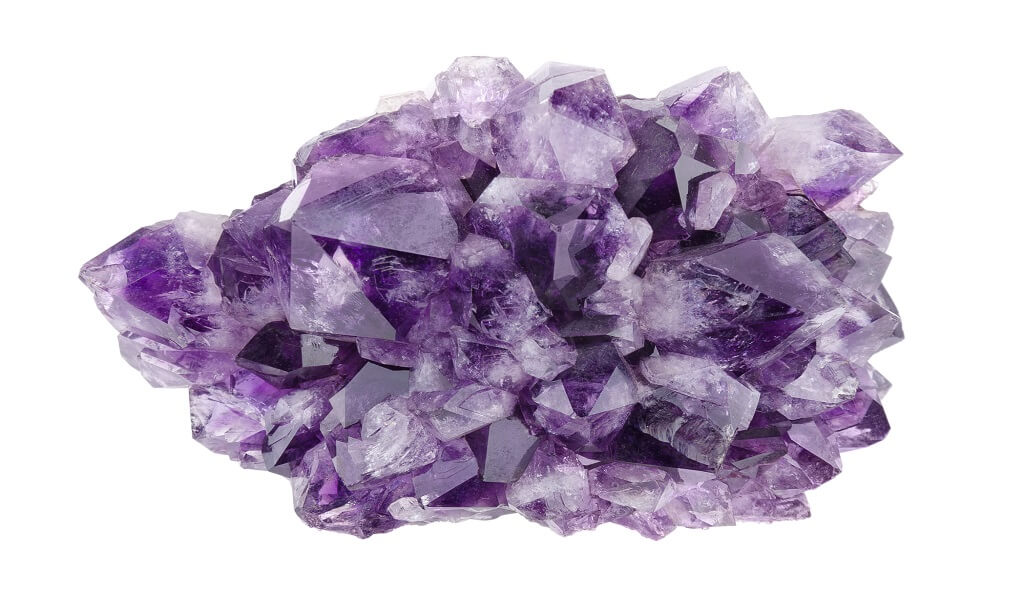
Color:
As mentioned earlier, the deeper the purple the better the quality of the Amethyst.
What you actually purchase will, of course, depend on your personal taste.
Some of the pink Amethyst crystals, especially when paired with delicate silver mountings, can be very attractive, but if you want the best quality stones always look for a rich, deep purple color.
Clarity:
Amethyst is naturally vitreous (glassy) in luster, and genuine stones will contain inclusions and flaws, meaning that they will never be totally clear.
This is part of their attraction for most people.
Cut and Carat Weight:
Amethysts are ranked in value according to the depth of the color in the stone rather than measured in carats.
As to the cut of the stone, Amethyst is often faceted and highly polished and can be found in a wide variety of shapes and sizes.
Amethyst Healing Properties
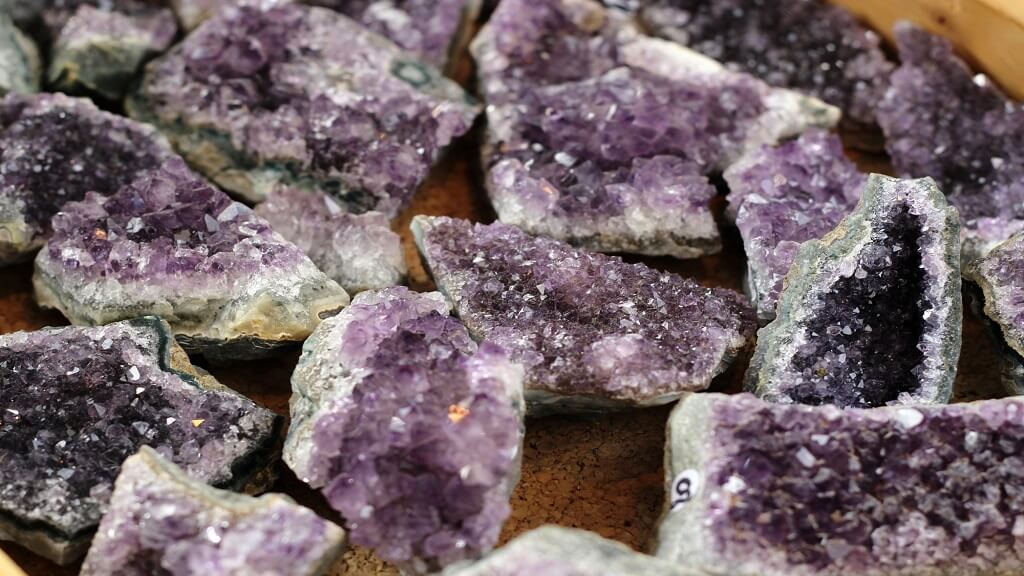
Amethyst is credited with many healing powers and is often referred to as a natural tranquilizer, possibly as a result of the presence of Lithium in its chemical make-up.
It is said to bring deep serenity and peace, enhance spiritual understanding and connection, block geopathic stress, and cleanse the environment of both physical and esoteric negativity.
Physical Healing Properties
Amethyst is often used to bring the physical systems of the body into balance and harmony.
It is said to boost the production of hormones and tune the endocrine system.
In addition, Amethyst has a cleansing effect on other crystals and never needs to be cleansed itself.
It is both absorbent and transformational, meaning that it removes negative or unwanted energies from the aura and disperses them, leaving space for positive energetic influences to enter.
The cleansing properties of this crystal are also used by healers to support the organs of elimination and to aid the body’s natural ability to detoxify the blood and cells.
The liver, kidneys, and lungs can all be strengthened during a crystal healing session by the application of Amethyst.
Other claims as to the efficiency of Amethyst in healing the physical body include easing tension and reducing the pain of headaches, treatment of hearing disorders, treating insomnia, and inducing restful sleep.
The digestive tract can also be treated with Amethyst as it is believed to regulate intestinal flora, remove parasites and encourage the reabsorption of water.
Mental & Emotional Healing Properties
Amethyst is said to be extremely beneficial to the mind. It is both calming and stimulating, depending on the needs of the individual, and also brings peace and serenity to an anxious or troubled mind.
Amethyst can be used to enhance the restful effects on the mind of regular meditation and is said to promote clarity of thinking and discernment.
It helps with insight and the application of common sense to some issues of the mental and emotional body, synthesizing scattered thoughts and helping to ameliorate the negative consequences of an over-active mind.
Amethyst is regarded as a balancing stone, helping to iron out the extremes of high or low moods and bringing in a sense of emotional centering. It is also said to dispel anger, fear, grief, rage, and anxiety.
Metaphysical Properties
Along with its reputation as a preventative against drunkenness and excess, Amethyst is believed to be a powerful stone of protection.
It has been used throughout history to afford the wearer protection from curses or ill wishes.
It counteracts the “evil eye” and is said to turn the negativity back upon the person who is doing the ill wishing.
Amethyst also offers protection to the environment and many people like to have a piece of this crystal near to their workstation or desk to help counteract the effects of “sick building” syndrome.
Amethyst is believed to have a high vibration that is capable of dispersing harmful energies and transmuting them into positive ones.
Spiritual Healing Properties
Amethyst has a high spiritual vibration that is aligned with both the Third eye and Crown chakras.
In addition, it stimulates the Higher Crown, opening a channel between this earthly realm and the Divine.
It aids in making connections on a spiritual level by opening the Crown and Third Eye so that you are able to see and hear the symbols, messages, and insights being delivered to you by your guides, teachers, and other spiritual companions.
This crystal is believed to promote the expansion of the Higher Mind, especially during focussed meditation.
It is soothing and calming during spiritual development work, enabling you to let go of the fear of the unknown and to accept the gifts of Divine wisdom that come your way.
How to Use Amethyst
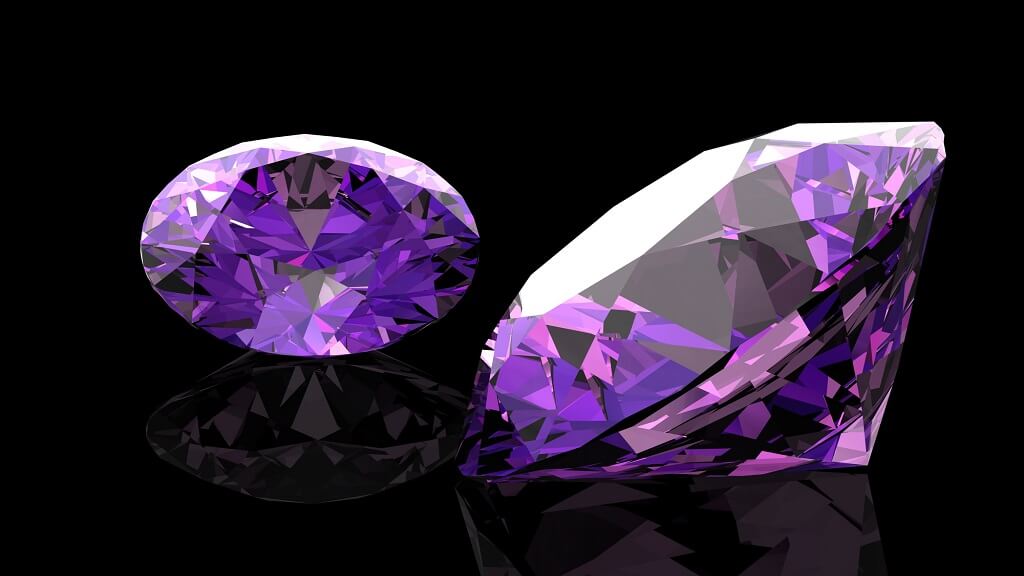
As Jewelry
Amethyst earrings and necklaces are perfect if you want to access the healing vibration of this crystal all day.
They also look good and do not need a lot of care to keep them in top condition. A dramatic, and very attractive, way to wear Amethyst is in a head or forehead band.
This also brings the stone directly into contact with the Third Eye chakra, with which it has a natural vibrational resonance.
Amethyst worn anywhere on the body in the form of jewels or adornments can benefit a wide variety of both physical and emotional conditions.
See the sections above on the healing qualities of Amethyst for more detailed information.
In the Home and Office
A piece of Amethyst crystal, whether raw or cut, single or cluster, can be placed in the home or office to absorb the negative effects of emanations from electronic devices and artificial light.
Larger specimens can be used to create focal points for displays of all kinds, not just crystal collections.
Many people like to carry a small piece of tumbled stone, or an Amethyst carved into an angel, animal, or heart shape to remind them of the Universal healing energies that are always around us, just waiting for us to access them.
Final Thoughts & Conclusion
An Amethyst of any size is an absolute must for any crystal collection.
It is so versatile in its applications and so useful as an addition to your healing or meditation rituals that it may well form the keystone to all of your other pieces.
References
Gemsociety | Geology | GIA | Mindat | Wikipedia

